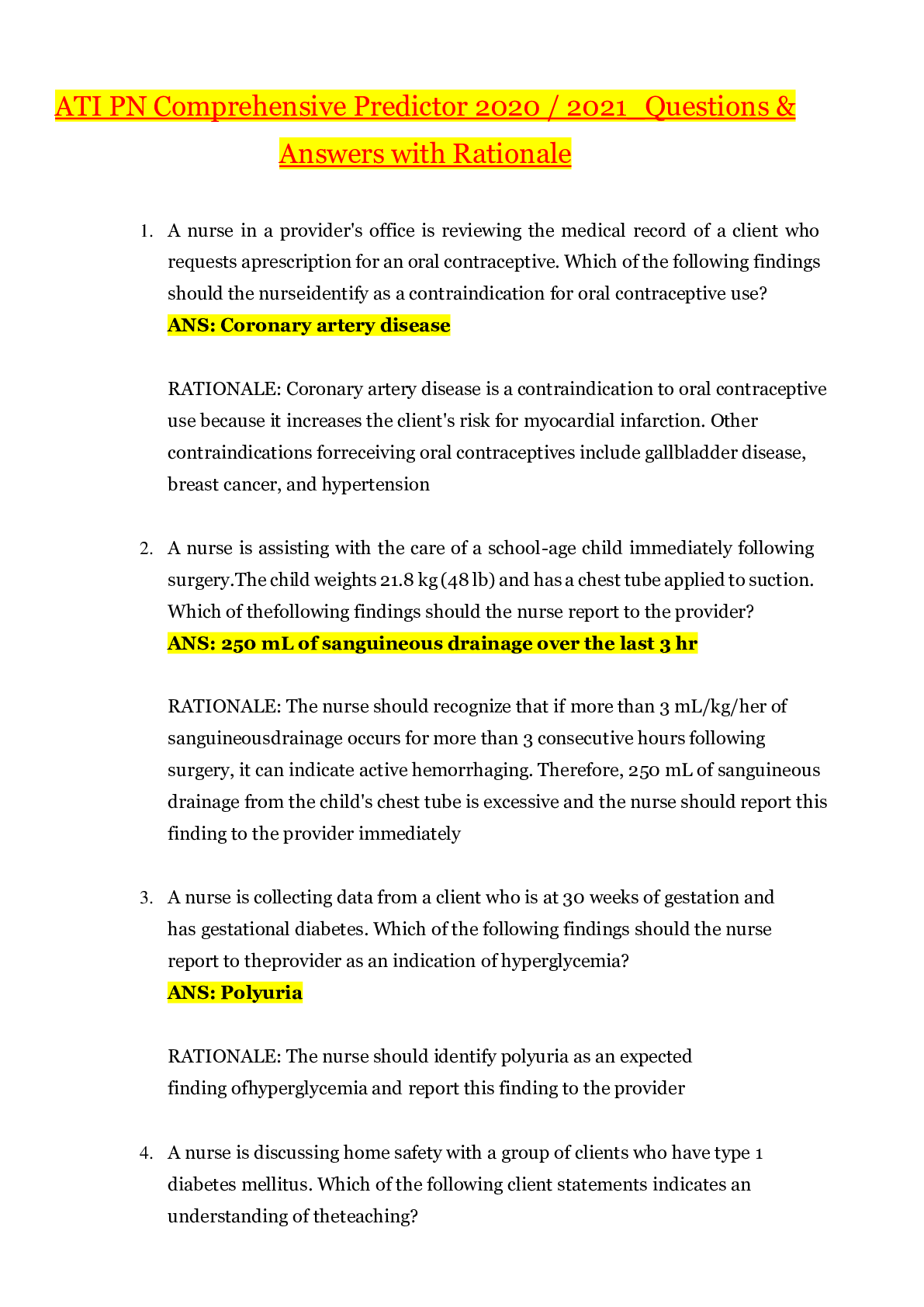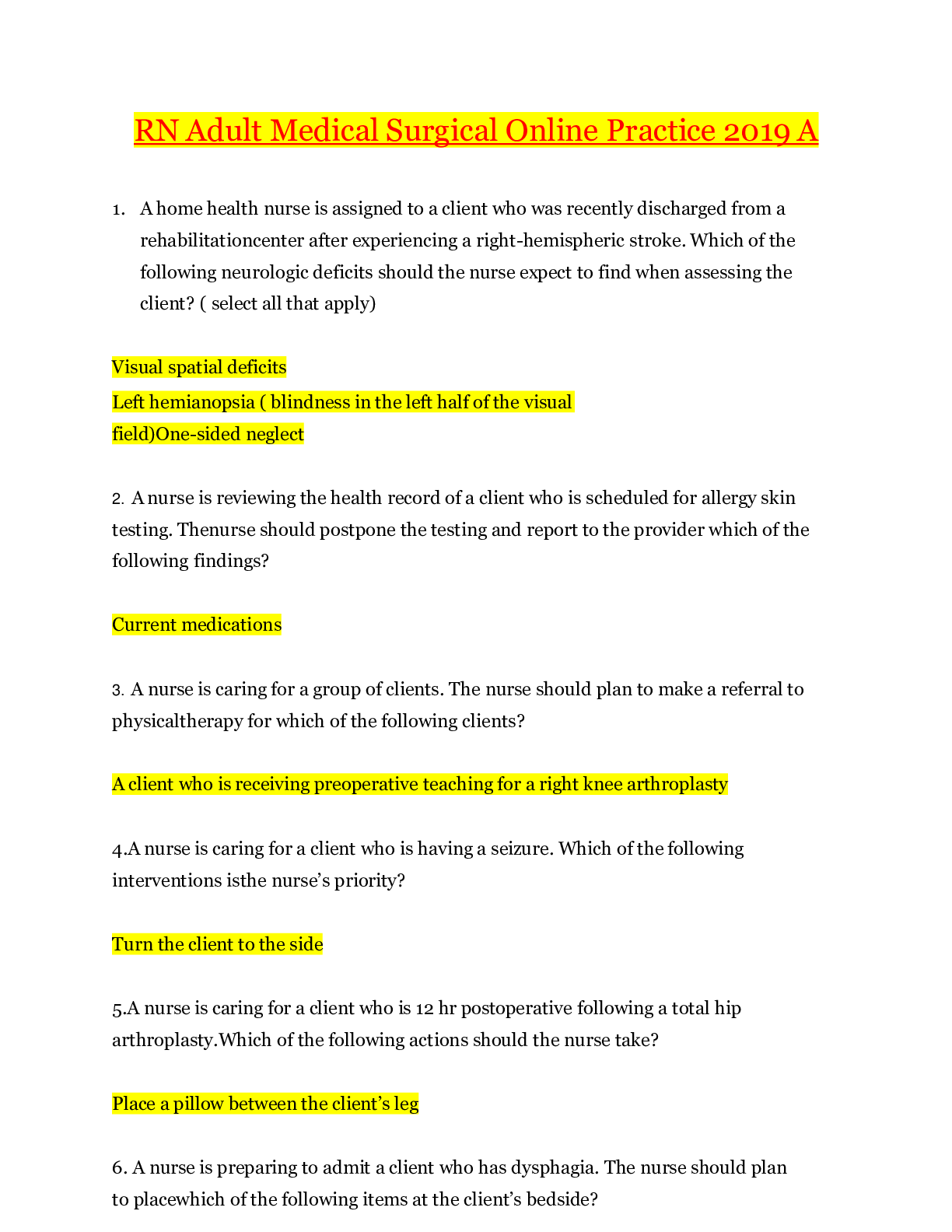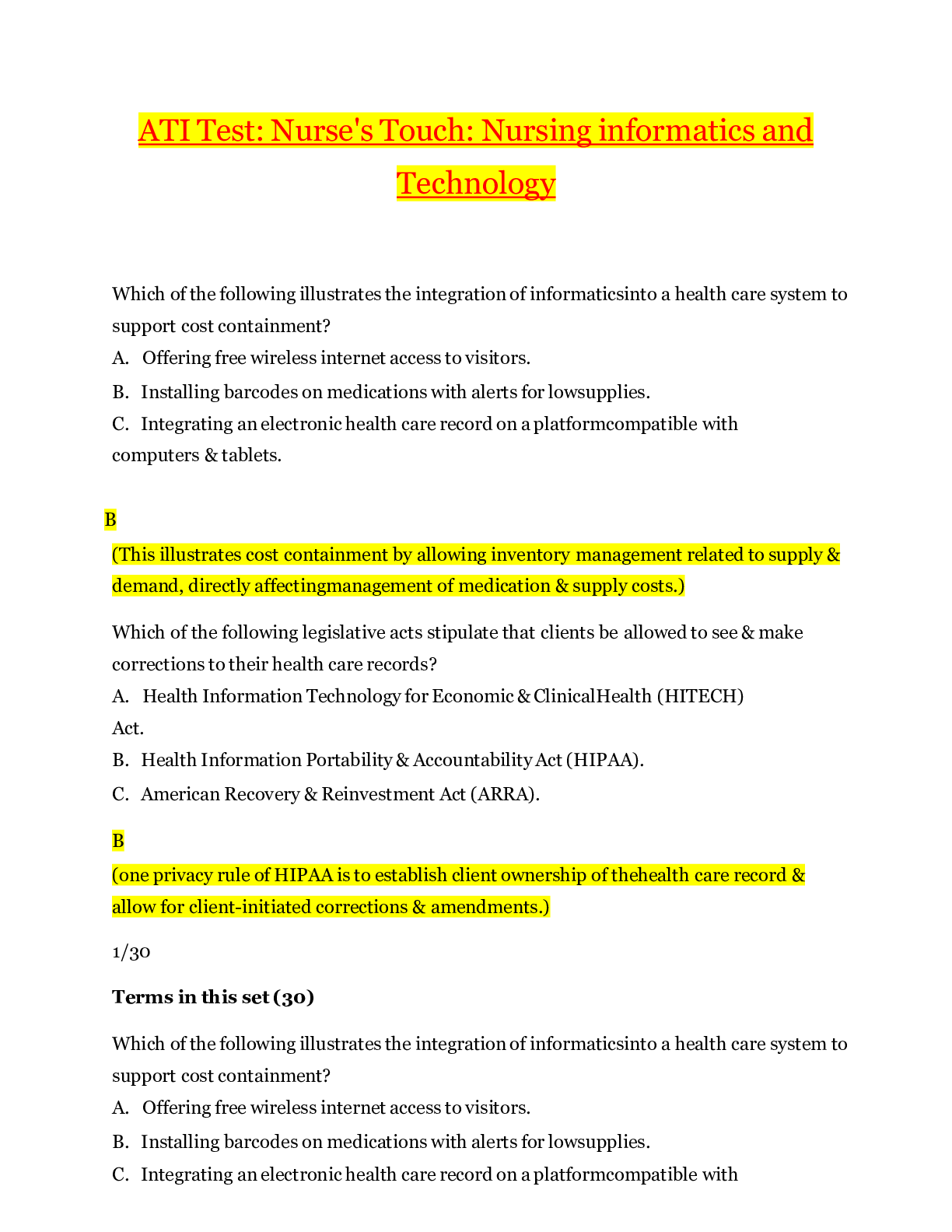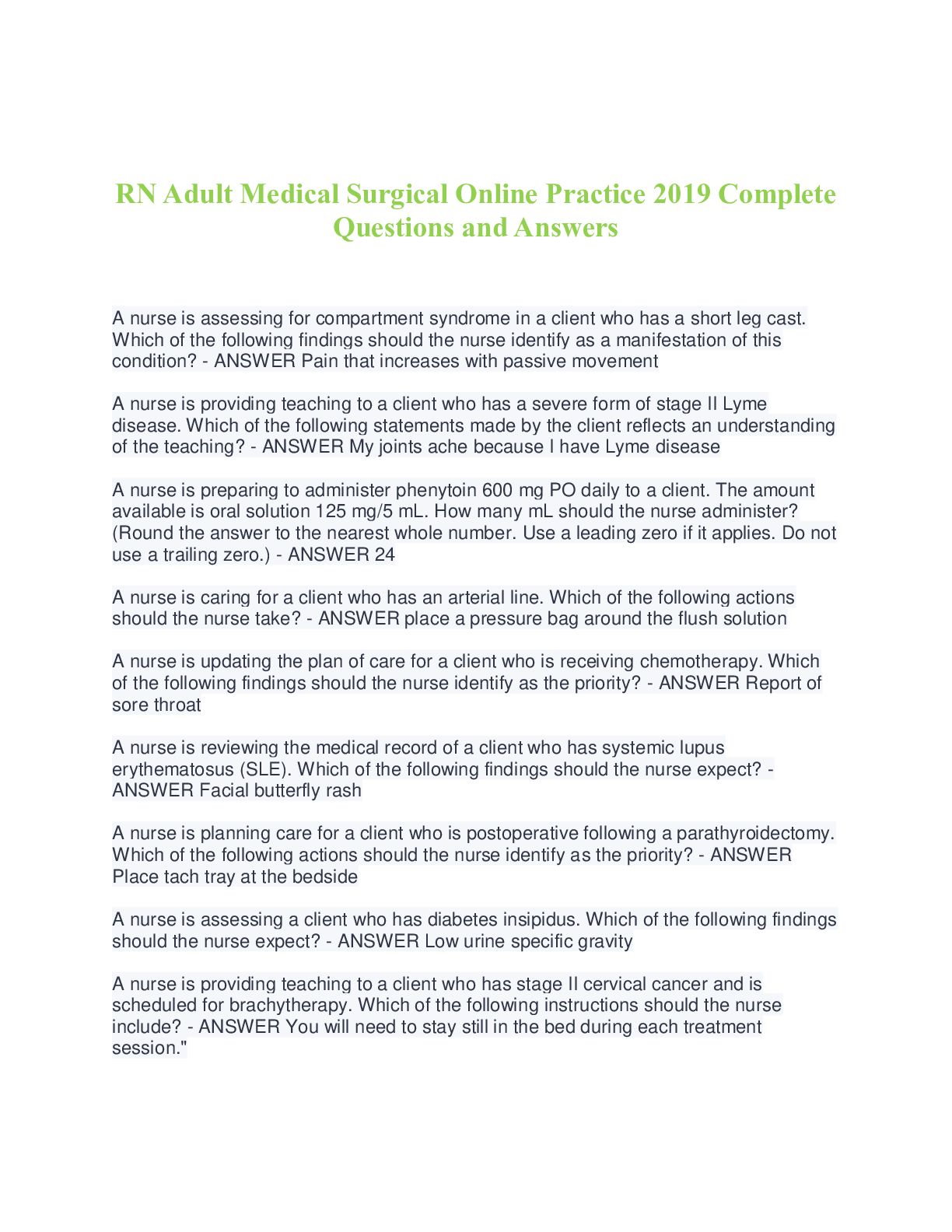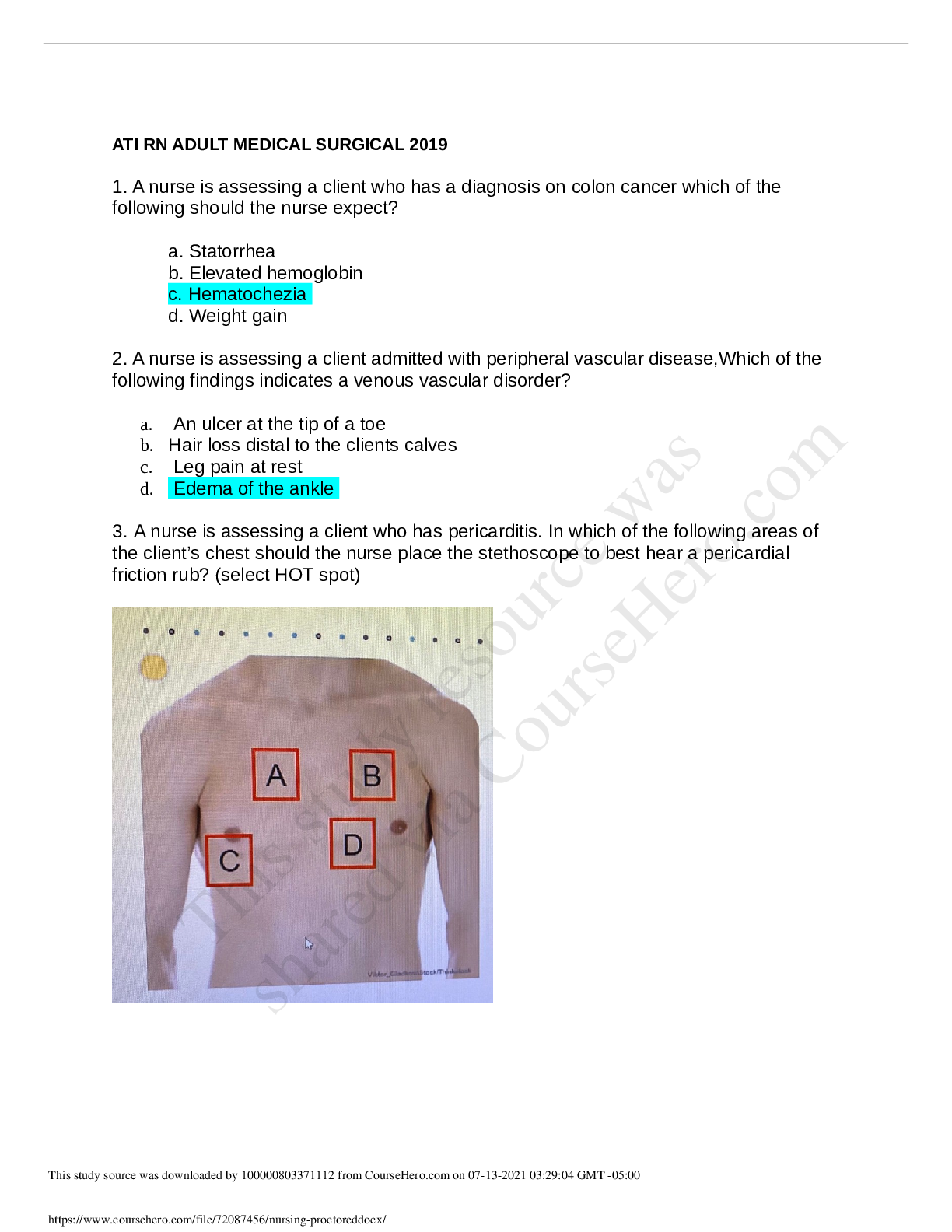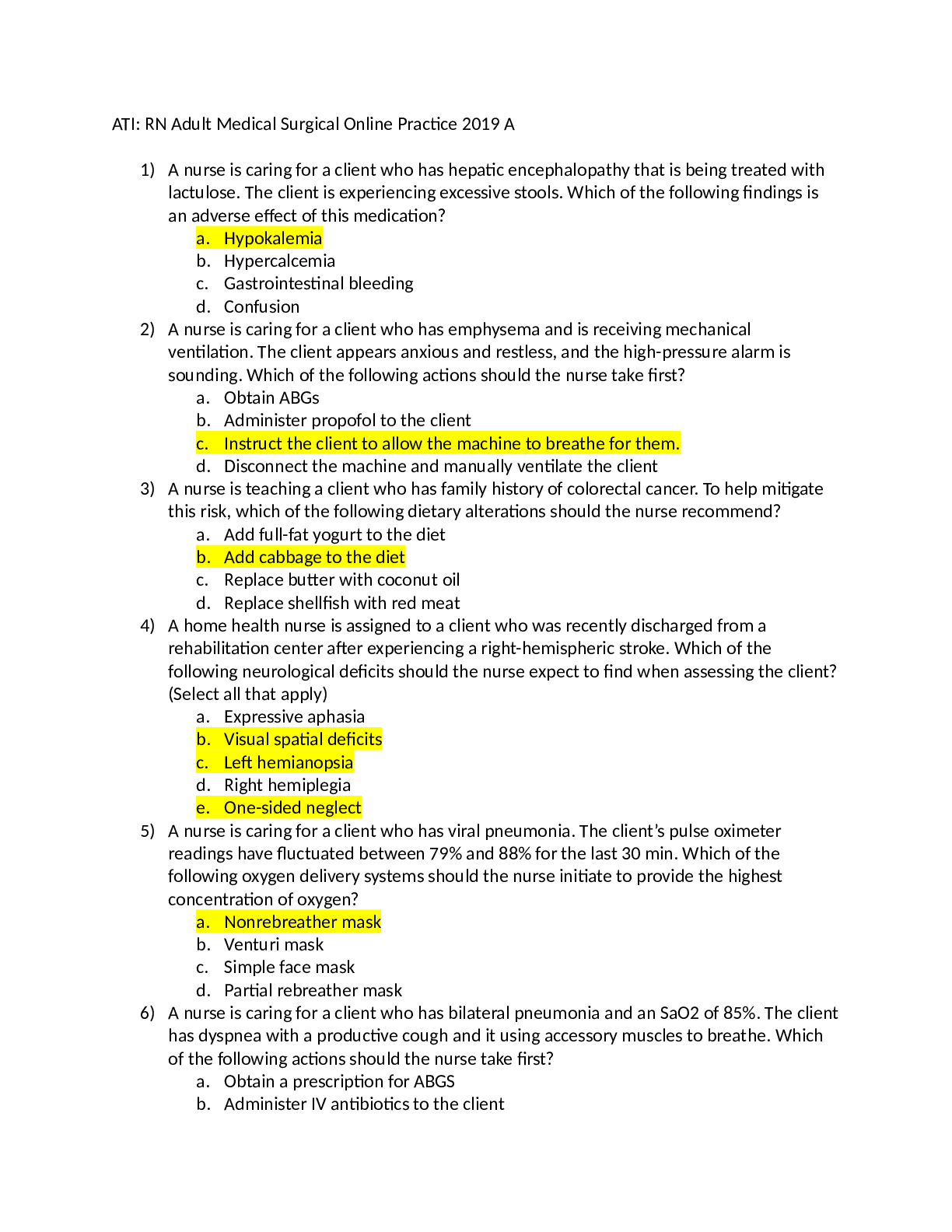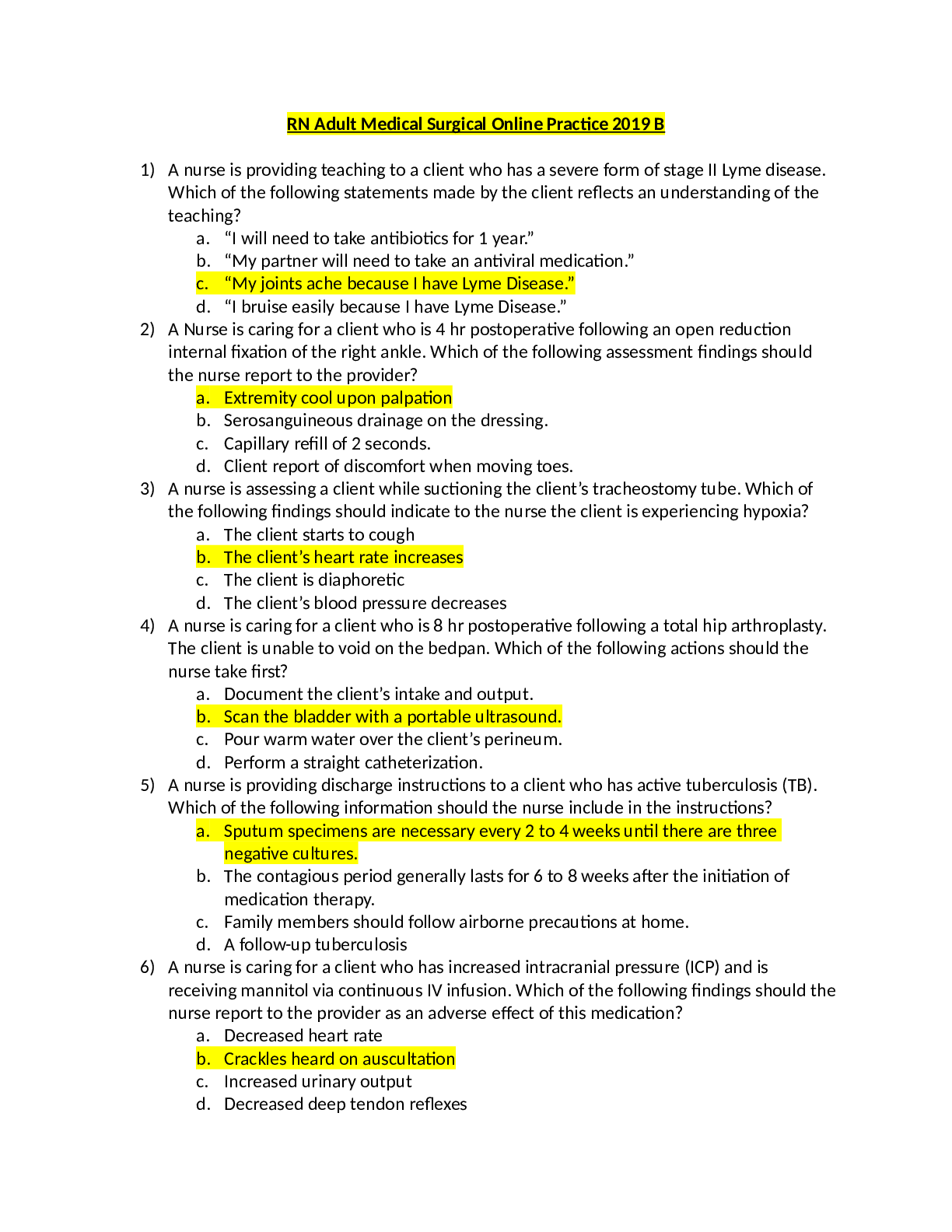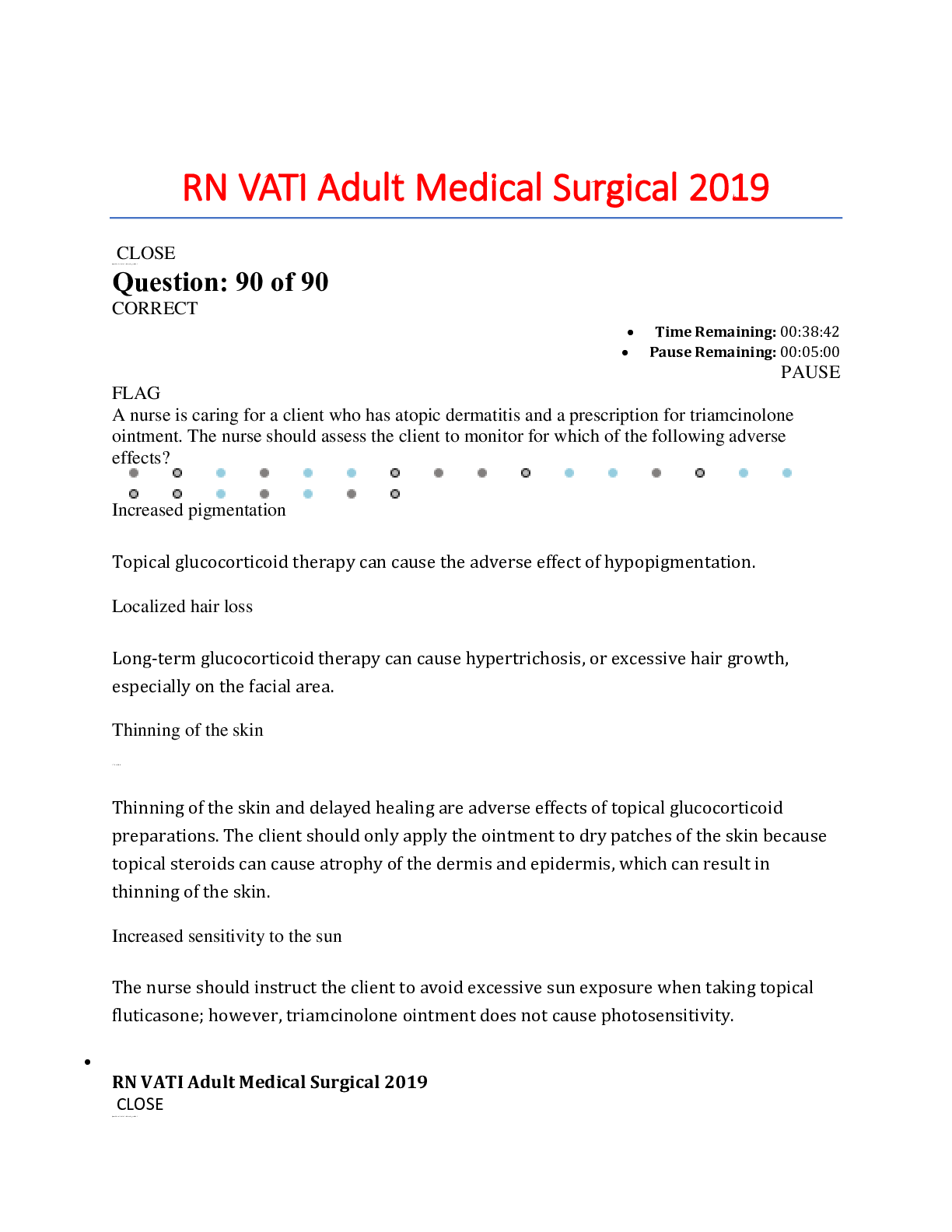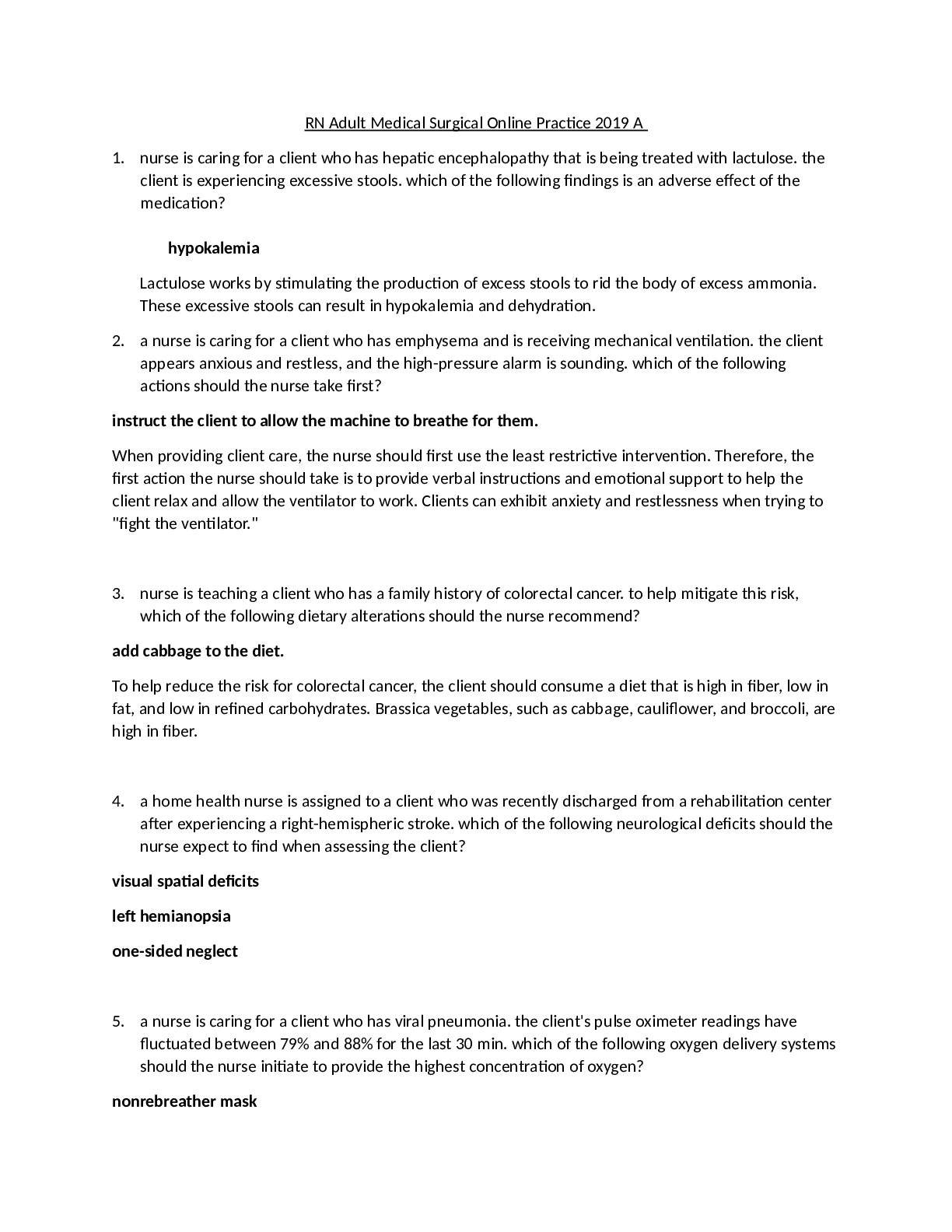*NURSING > QUESTIONS and ANSWERS > ATI RN Adult Medical Surgical Online Practice B_2019 (UPDATED 2022 | RN Adult Medical Surgical Onlin (All)
ATI RN Adult Medical Surgical Online Practice B_2019 (UPDATED 2022 | RN Adult Medical Surgical Online Practice 2019 B_Graded A+
Document Content and Description Below
RN Adult Medical Surgical Online Practice 2019 B 1) A nurse is providing teaching to a client who has a severe form of stage II Lyme disease. Which of the following statements made by the client re... flects an understanding of the teaching? a. “I will need to take antibiotics for 1 year.” b. “My partner will need to take an antiviral medication.” c. “My joints ache because I have Lyme Disease.” d. “I bruise easily because I have Lyme Disease.” 2) A Nurse is caring for a client who is 4 hr postoperative following an open reduction internal fixation of the right ankle. Which of the following assessment findings should the nurse report to the provider? a. Extremity cool upon palpation b. Serosanguineous drainage on the dressing. c. Capillary refill of 2 seconds. d. Client report of discomfort when moving toes. 3) A nurse is assessing a client while suctioning the client’s tracheostomy tube. Which of the following findings should indicate to the nurse the client is experiencing hypoxia? a. The client starts to cough b. The client’s heart rate increases c. The client is diaphoretic d. The client’s blood pressure decreases 4) A nurse is caring for a client who is 8 hr postoperative following a total hip arthroplasty. The client is unable to void on the bedpan. Which of the following actions should the nurse take first? a. Document the client’s intake and output. b. Scan the bladder with a portable ultrasound. c. Pour warm water over the client’s perineum. d. Perform a straight catheterization. 5) A nurse is providing discharge instructions to a client who has active tuberculosis (TB). Which of the following information should the nurse include in the instructions? a. Sputum specimens are necessary every 2 to 4 weeks until there are three negative cultures. b. The contagious period generally lasts for 6 to 8 weeks after the initiation of medication therapy. c. Family members should follow airborne precautions at home. d. A follow-up tuberculosis 6) A nurse is caring for a client who has increased intracranial pressure (ICP) and is receiving mannitol via continuous IV infusion. Which of the following findings should the nurse report to the provider as an adverse effect of this medication? a. Decreased heart rate b. Crackles heard on auscultation c. Increased urinary output d. Decreased deep tendon reflexes 7) A nurse is providing discharge teaching to a client who is postoperative following a modified radical mastectomy. Which of the following instructions should the nurse include? a. Flex the affected arm when ambulating b. Numbness can occur along the inside of the affected arm c. Begin active range-of-motion exercises 1 day after surgery d. Dress in clothing that fits snugly 8) A nurse is providing education to a client who has tuberculosis (TB) and their family. Which of the following information should the nurse include in the teaching? a. After 1 week of medication, TB is no longer communicable. b. Dispose of contaminated tissues in a paper bag. c. Airborne precautions are necessary in the home. d. Family members in the household should undergo TB testing. 9) A nurse is providing discharge teaching about infection prevention to a client who has AIDS. Which of the following statements by the client indicates understanding of the teaching? a. “I will eat a salad at least once each day to increase my intake of vitamin K.” b. “I can work in my flower garden as long as I wear gardening gloves to cover my skin.” c. “I will no longer floss my teeth after brushing my teeth.” d. “I can sip on a glass of juice for at least 2 hours before I should discard it.” 10) A nurse is assessing a client who is at risk for the development of pernicious anemia resulting from peptic ulcer disease. Which of the following images depicts a condition caused by pernicious anemia? a. 11) A nurse is reviewing the laboratory results of a client who has aplastic anemia. Which of the following findings indicates a potential complication? a. RBC count 5.2 million/mm3 b. WBC count 2,000/mm3 c. Platelets 380,000/mm3 d. Potassium 4 mEq/L 12) A nurse is assessing heart sounds of a client who reports substernal precordial pain. Identify which of the following sounds the nurse should document in the client’s medical record by listening to the audio clip. a. Murmur b. S4 c. Pericardial friction rub d. Ventricular gallop 13) A nurse is admitting a client who has active tuberculosis. Which of the following types of transmission precautions should the nurse initiate? a. Airborne b. Droplet c. Contact d. Protective environment 14) A nurse is preparing to present a program about prevention of atherosclerosis at a health fair. Which of the following recommendations should the nurse plant to include? (select all that apply) a. Follow a smoking cessation program b. Maintain an appropriate weight c. Eat a low-fat diet d. Increase fluid intake e. Decrease intake of complex carbohydrates 15) A home health nurse is providing teaching to a client who has a stage 1 pressure injury on the greater trochanter of his left hip. Which of the following instructions should the nurse include in the teaching? a. Clean the wound daily with an antiseptic b. Use a donut-shaped pillow when sitting in a chair c. Change position every hour d. Massage the area two times daily 16) A nurse is providing teaching to a client who takes ginkgo biloba as an herbal supplement. Which of the following statements should the nurse make? a. “Ginkgo biloba relieves nausea for people who have vertigo.” b. “Taking ginkgo biloba will help relieve your joint pain.” c. “Ginkgo biloba can cause an increased risk for bleeding.” d. “Taking ginkgo biloba decreases the risk of migraine headache.” 17) A nurse is providing teaching to a client who has a new prescription for psyllium. Which of the following information should the nurse include in the teaching? a. Drink 240 mL (8 oz) of water after administration. b. Expect results in 4 to 6 hr c. Take this medication before meals to increase appetite. d. Reduce dietary fiber intake to improve medication absorption. 18) A nurse is assessing a client who has advanced lung cancer and is receiving palliative care. The client has just undergone thoracentesis. The nurse should expect a reduction in which of the following common manifestations of advanced cancer? a. Dyspnea b. Hemoptysis c. Mucus production d. Dysphagia 19) A nurse is caring for a client who is receiving mechanical ventilation via a tracheostomy tube. The nurse should recognize that which of the following complications is associated with long-term mechanical ventilation? a. Elevated blood pressure b. Dehydration c. Stress ulcers d. Hypernatremia 20) A nurse is assessing a client who is postoperative following a thyroidectomy. Which of the following findings is the nurse’s priority? a. Moderate serosanguinous drainage on the dressing b. Calcium 9.5 mg/dL c. Temperature 38.9C (102F) d. Decreased bowel sounds 21) A nurse is teaching a family about the care of a parent who has a new diagnosis of Alzheimer’s disease. Which of the following information should the nurse include in the teaching? a. Position tabletop clocks with multi-colored backgrounds throughout the home. b. Explain how to complete a task while having the client do the task. c. Place a calendar on the wall with days and weeks included. d. Create complete outfits and allow the client to select one each day. 22) A nurse on a medical-surgical unit is reviewing the medical record of an older adult client who is receiving IV fluid therapy. Which of the following client information should indicate to the nurse that the client requires re-evaluation of the IV therapy prescription? a. Blood pressure (118/68) b. Prescribed medications (propranolol, metformin, alendronate sodium) c. Oxygen saturation (96%) d. BUN (29 mg/dL) 23) A nurse is providing preoperative teaching for a client who is scheduled for a mastectomy. Which of the following statements should the nurse make? a. “You should accept your body image change before discharge.” b. “It is important for you to look at the incisional site when the dressings are removed.” c. “I will refer you to community resources that can provide support.” d. “The scar will remain red and raised for many years after surgery.” 24) A nurse is caring for a client following extubating of an endotracheal tube 10 min ago. Which of the following findings should the nurse report to the provider immediately? a. Stridor b. Oral secretions c. Hoarseness d. Sore throat 25) A nurse is assessing a client who has diabetes insipidus. Which of the following findings should the nurse expect? a. Low urine specific gravity b. Hypertension c. Bounding peripheral pulses d. Hyperglycemia 26) A nurse is assessing a client who is postoperative following a transurethral resection of the prostate (TURP) and notes clots in the client’s indwelling urinary catheter and a decrease in urinary output. Which of the following actions should the nurse take? a. Remove the client’s indwelling urinary catheter b. Irrigate the indwelling urinary catheter [Show More]
Last updated: 1 year ago
Preview 1 out of 31 pages
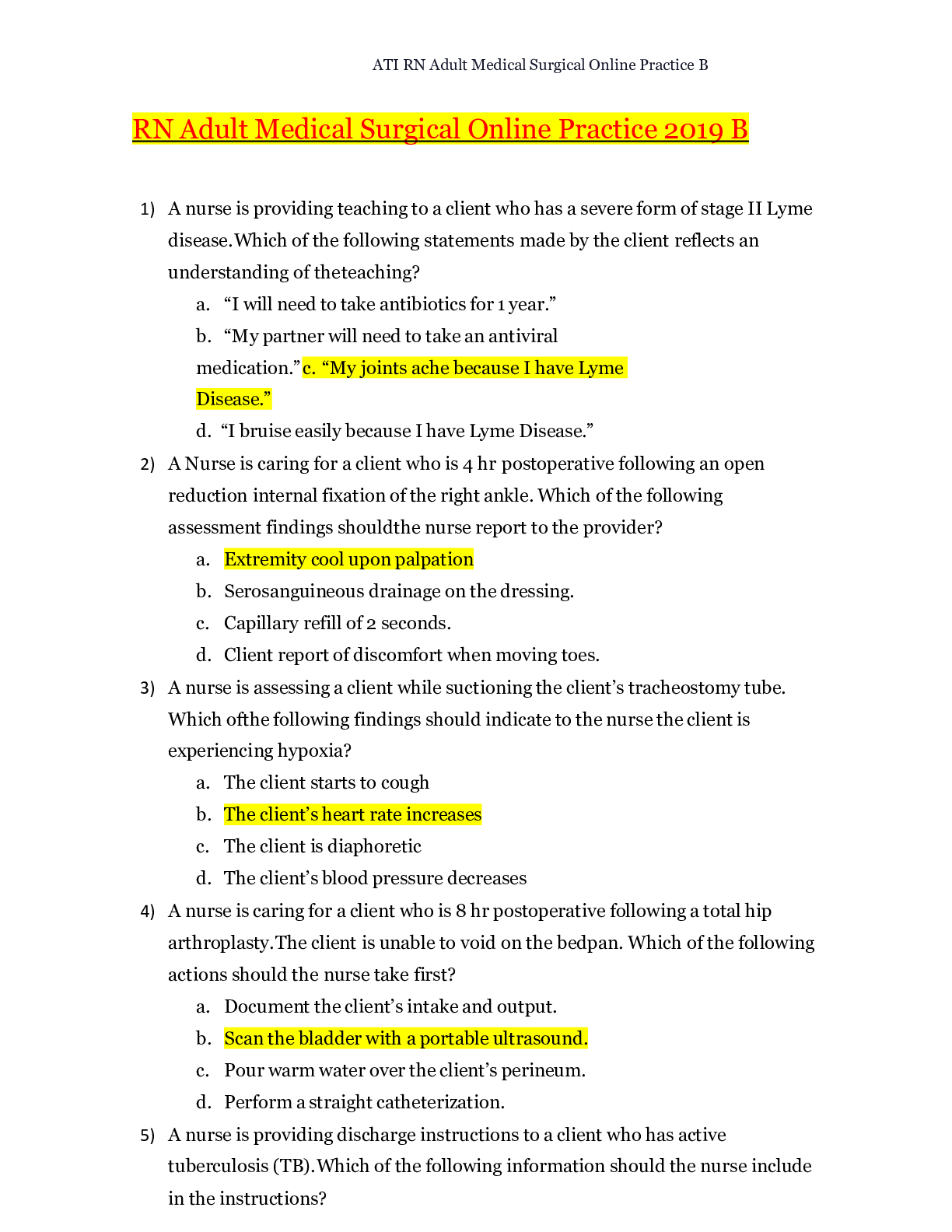
Reviews( 0 )
Document information
Connected school, study & course
About the document
Uploaded On
Apr 15, 2021
Number of pages
31
Written in
Additional information
This document has been written for:
Uploaded
Apr 15, 2021
Downloads
0
Views
234

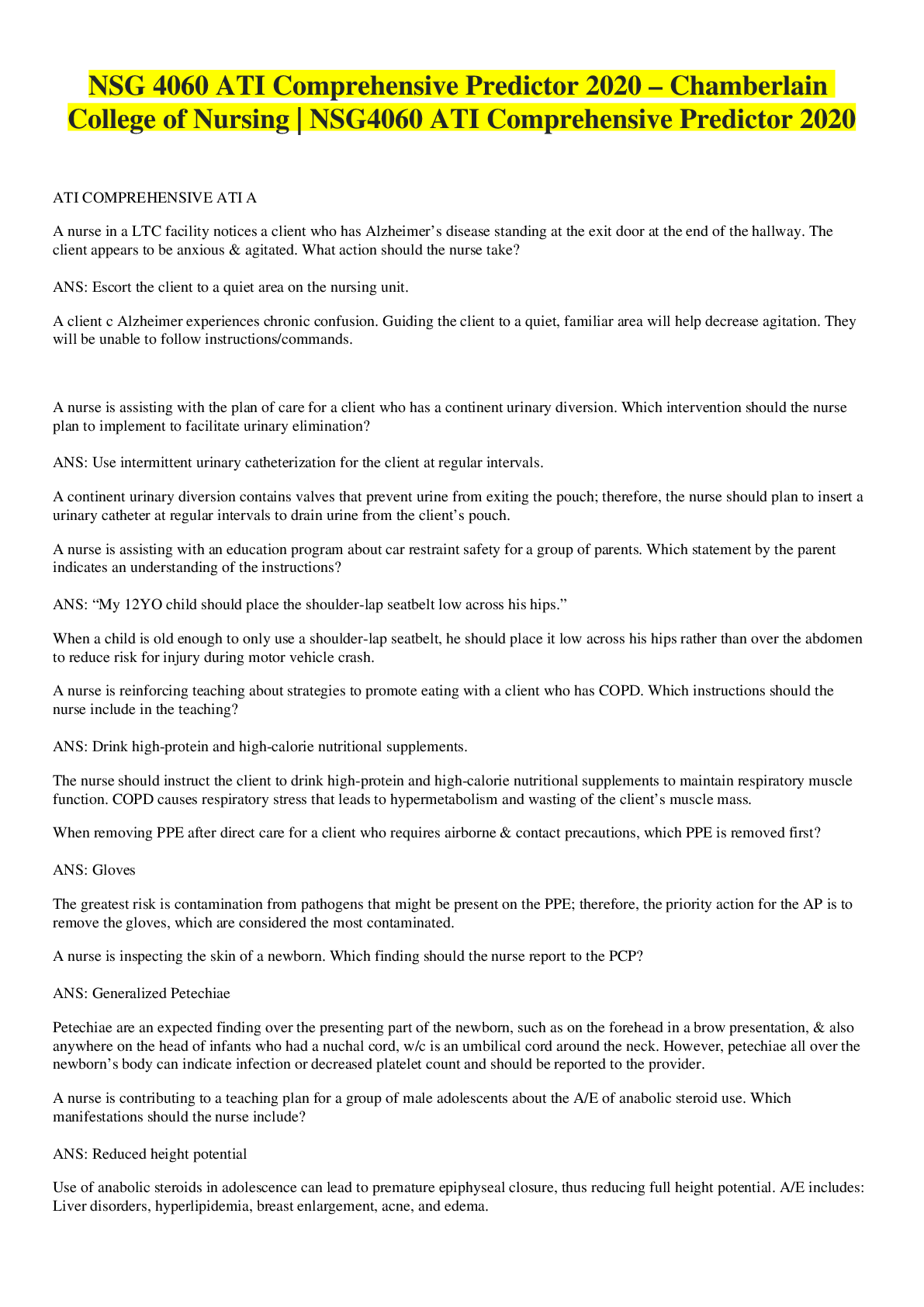


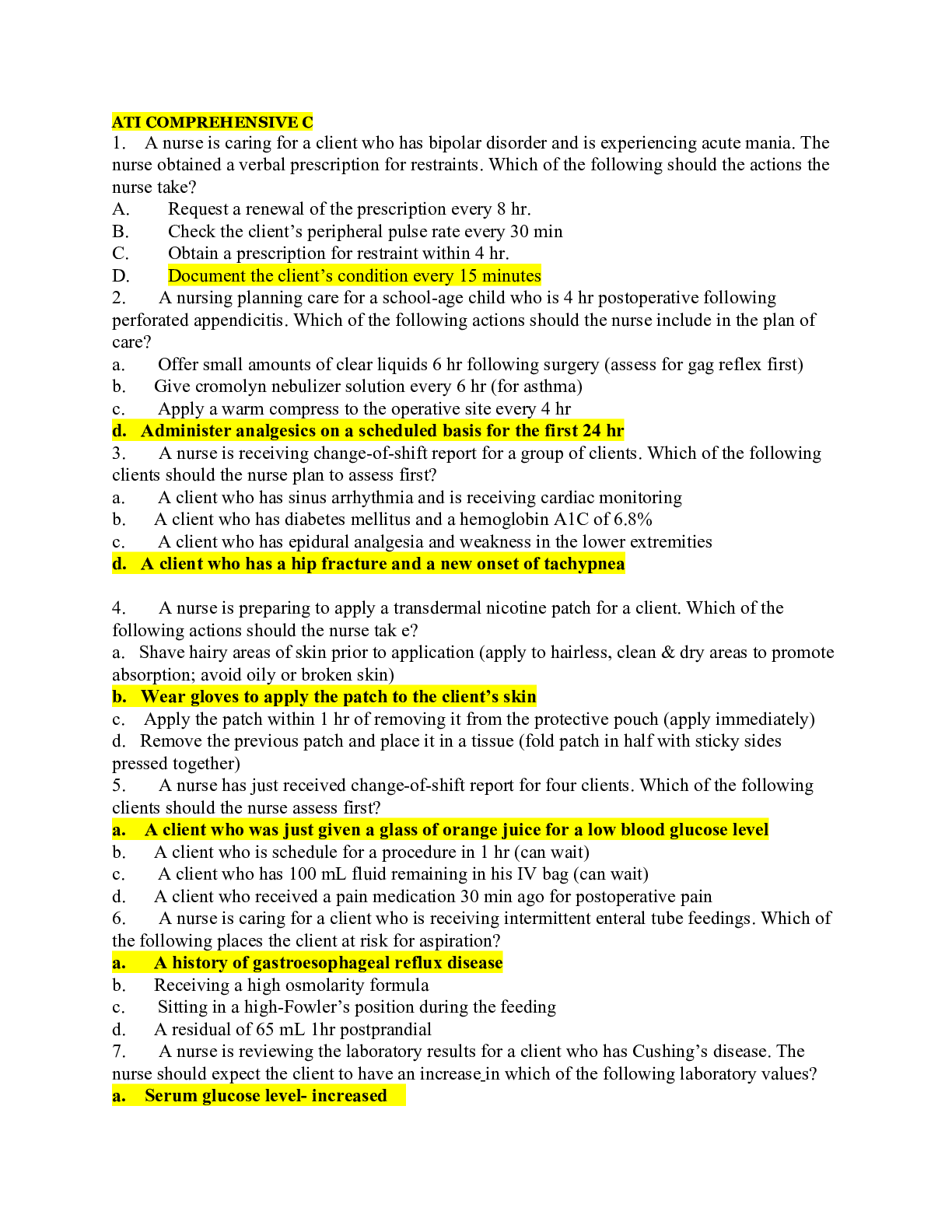
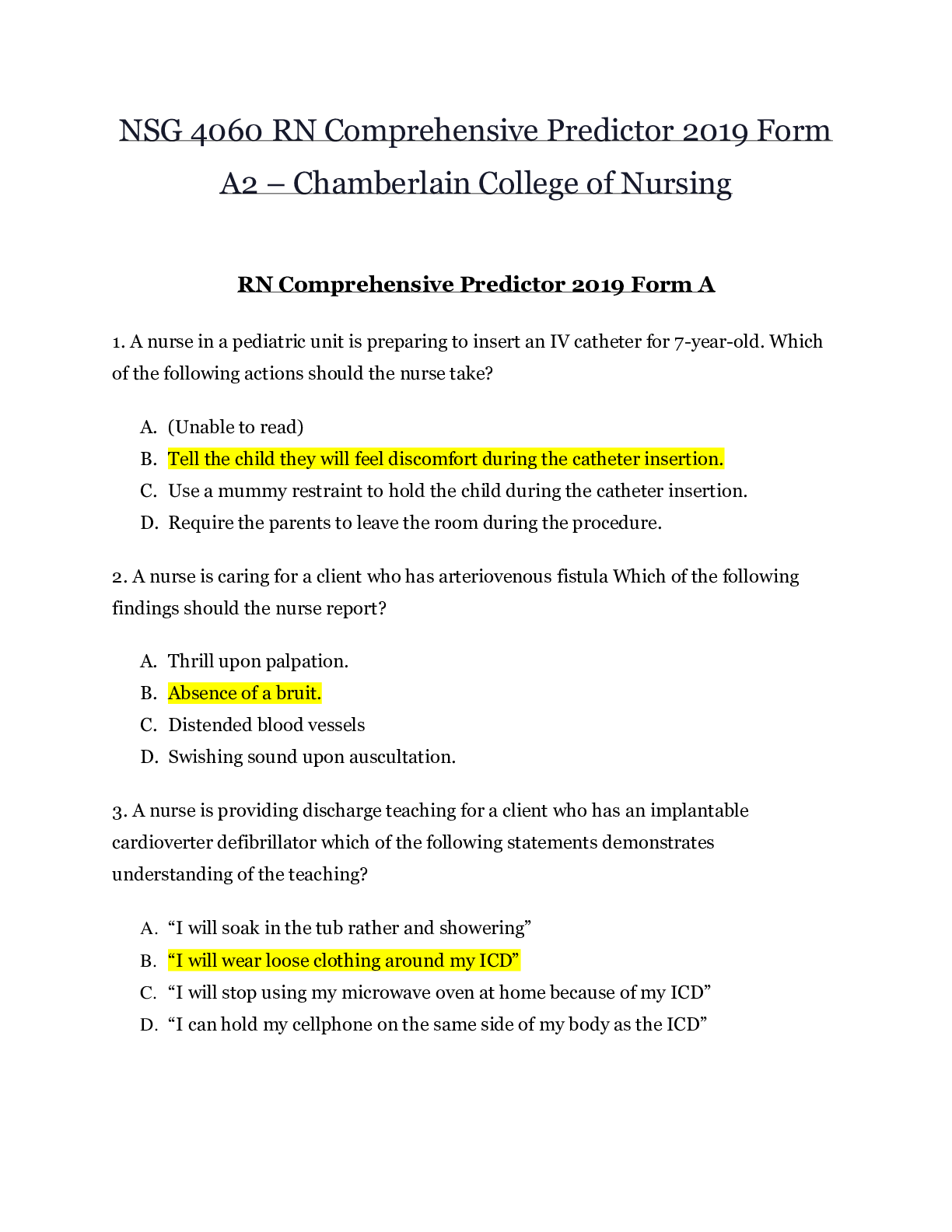
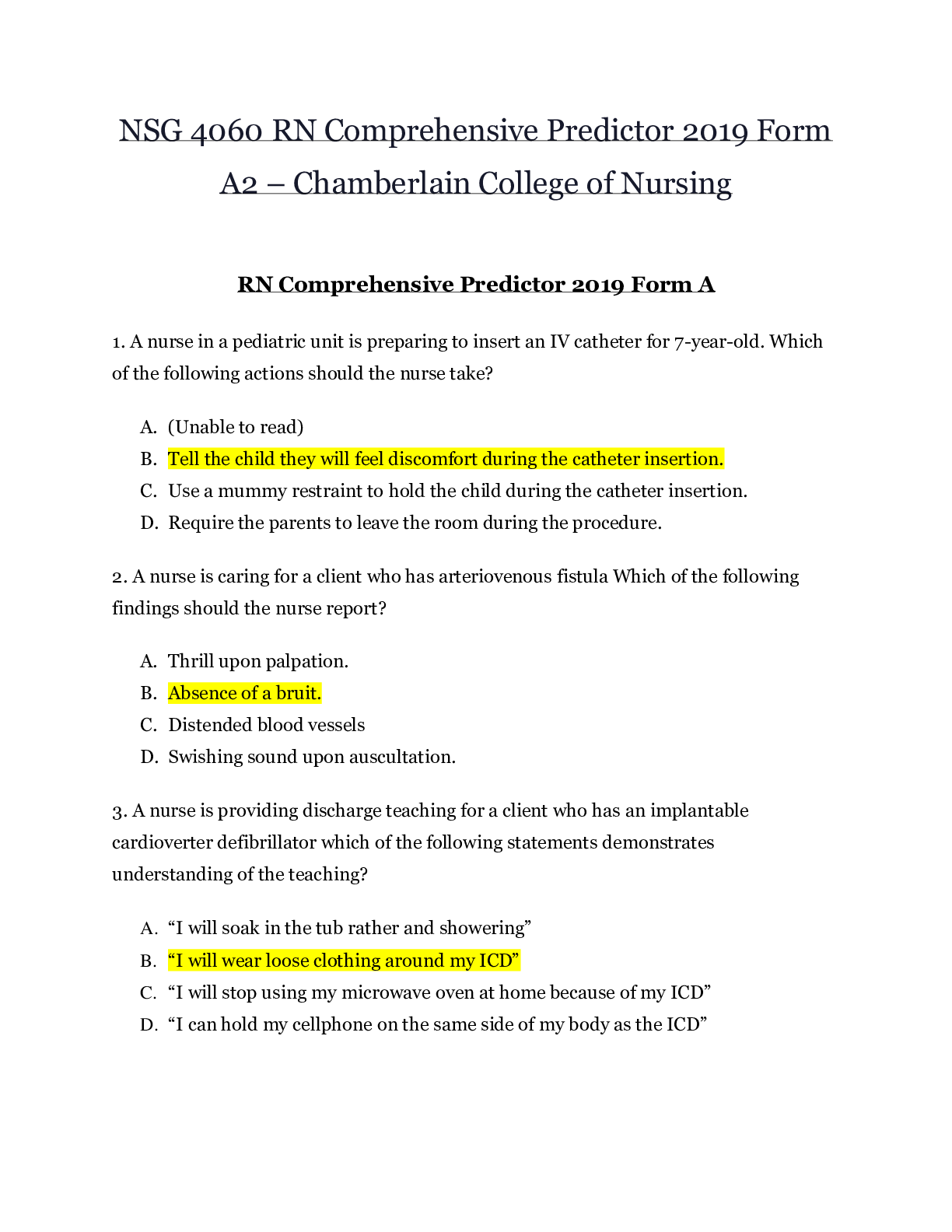
 – Concorde career College.png)

